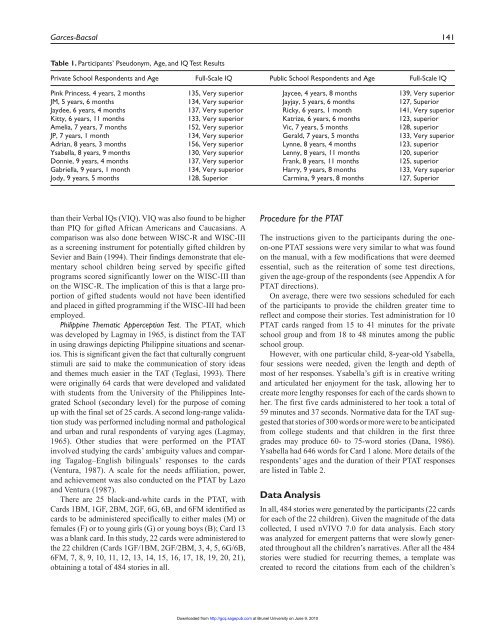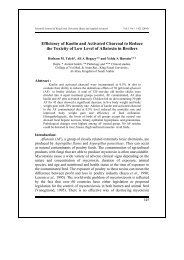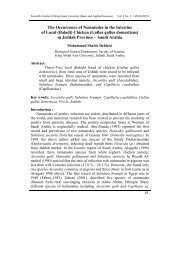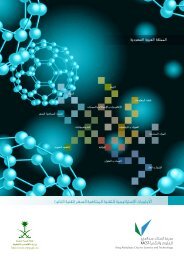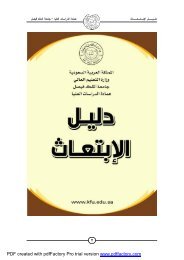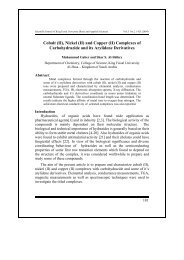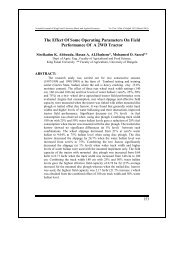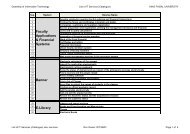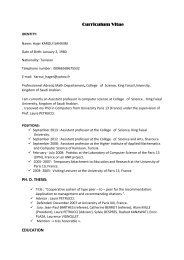140 <strong>Gifted</strong> <strong>Child</strong> <strong>Quarterly</strong> 54(2)a Hispanic version of the TAT—consisting of chromaticstimuli depicting Hispanic characters in urban settings—wasevaluated by Malgady et al. The TEMAS was administeredto 73 low socioeconomic status students in grades K to 6 inpublic schools in New York City. This group was comparedwith 210 Puerto Rican children identified to have clinicalproblems and recruited by teacher referrals in New York Citypublic schools. Malgady et al.’s study was spurred by previousresearch indicating that Hispanic children showed greaterverbal fluency in telling stories about TEMAS pictures whencompared with the TAT pictures. However, the TEMAS wasnot used to demonstrate the predominant socio-affective concernsof the children in the study. Malgady et al. wanted tofurther investigate the psychometric properties of the TEMASto examine its clinical usefulness.Gust (1996) has also advocated the efficacy of the children’sself-report and projective inventory as potential toolsin assessing the emotional and social needs of the gifted agedbetween 5 and 12 years. The self-report consisted of statementsdealing with possible clinical concerns as well asperceived competence. The projective inventory, on theother hand, included instruments such as the kinetic familydrawing, projective story cards, and using colors to depictemotions. Gust reported a case study of a 7-year-old boy anddiscussed how the boy’s responses to the projective instrumentsprovided the author with insight into the child’s socialand emotional world. However, an in-depth analysis of thesocio-affective themes emerging from projective tests wasnot discussed.The use of the TAT as the instrument in discerning thesocio-affective concerns of ethnically diverse and culturallydifferent gifted children in the primary school years is yet tobe explored. The present study aims to address this gap inthe literature and illuminate gifted Filipino students’ socioaffectiveconcerns and “inner life” through a qualitativeanalysis of their narratives in the Philippine adaptation of theThematic Apperception Test (PTAT).Specifically, I examined how gifted Filipino children characterizefamily relationships, school-related concerns, peerissues, and spirituality concerns through the stories that theycreate in the PTAT. I also looked into the differences betweenthe private and public school gifted children’s themes andnarratives. Rather than come up with a predefined templateof socio-affective issues and concerns as is commonly foundin pencil-and-paper tests, I believe that a more groundedanalysis of their stories would be a more subtle and incisivemethodology in discerning their inner affective states.MethodTwenty-two children aged between 4 and 9 years participatedin the study. Eleven children were from the private schoolsetting, and 11 students were from a public school setting.The children were nominated by their teachers (for bothgroups) or by developmental pediatricians (for children fromprivate school settings). Initially, 15 students were nominatedfor the private school group and 21 students for the publicschool group. Purposive sampling was used to get only studentswho obtained a full-scale IQ score of 120 or more(superior category) on the Wechsler Intelligence Scale for<strong>Child</strong>ren–Revised (WISC-R). The objectives of the researchwere detailed in the letter provided to the school principaland the parents to obtain informed consent.Pseudonyms were used to protect the participants’ anonymity(see Table 1). The range of the children’s IQs wasfrom 120 (8-year-old Lenny from the public school setting)to 156 (8-year-old Adrian from the private school group).Table 1 provides details of the names, ages, and IQs of theparticipants.A supervisory team of clinical practitioners and developmentalpsychologists from the University of the Philippinesalso reviewed the research framework and the use of theprojective instrument for ethical viability. The respondents’anonymity was also protected during the entire data collectionprocess; identifying marks were subsequently removed to furtherpreserve the confidentiality of the research proceedings.RespondentsPrivate school respondents. Among respondents from privateschools, four were from big school settings. (A big schoolis operationally defined as a school that has two or moresections per primary level. The school also has more than20 students in a single classroom and has been in existencefor the past 20 years and more.) Seven children were from agifted school setting. (A gifted school is operationally definedas an establishment that specifically claimed to cater to theneeds of gifted and talented children. The school has 7 to 25students per class, with one section per grade level.)Public school respondents. The public school in the study hasbeen in existence since the 1940s in the Quezon City area.The school has a total student population of more than 2,000,from the preschool to the secondary level. On average, therewere eight sections per class in the primary and secondarylevels, with a total of 50 to 60 students per classroom.Measurement InstrumentsThe WISC-R was used as the screening instrument for thisstudy because it is a widely used instrument for the identificationof ethnically different gifted groups (Johnson, 1994)and has also been used to increase the number of underrepresentedminorities for selection in gifted and talented programsin the United States (Masten & Morse, 1995). Saccuzzo,Johnson, and Russell (1992) compared the verbal and performanceIQs of gifted African American, Caucasian, Filipino,and Hispanic children in Grades 1 to 9. Results indicated thatfor Filipino children their Performance IQs (PIQ) were higherDownloaded from http://gcq.sagepub.com at Brunel University on June 9, 2010
Garces-Bacsal 141Table 1. Participants’ Pseudonym, Age, and IQ Test ResultsPrivate School Respondents and Age Full-Scale IQ Public School Respondents and Age Full-Scale IQPink Princess, 4 years, 2 months 135, Very superior Jaycee, 4 years, 8 months 139, Very superiorJM, 5 years, 6 months 134, Very superior Jayjay, 5 years, 6 months 127, SuperiorJaydee, 6 years, 4 months 137, Very superior Ricky, 6 years, 1 month 141, Very superiorKitty, 6 years, 11 months 133, Very superior Katrize, 6 years, 6 months 123, superiorAmelia, 7 years, 7 months 152, Very superior Vic, 7 years, 5 months 128, superiorJP, 7 years, 1 month 134, Very superior Gerald, 7 years, 5 months 133, Very superiorAdrian, 8 years, 3 months 156, Very superior Lynne, 8 years, 4 months 123, superiorYsabella, 8 years, 9 months 130, Very superior Lenny, 8 years, 11 months 120, superiorDonnie, 9 years, 4 months 137, Very superior Frank, 8 years, 11 months 125, superiorGabriella, 9 years, 1 month 134, Very superior Harry, 9 years, 8 months 133, Very superiorJody, 9 years, 5 months 128, Superior Carmina, 9 years, 8 months 127, Superiorthan their Verbal IQs (VIQ). VIQ was also found to be higherthan PIQ for gifted African Americans and Caucasians. Acomparison was also done between WISC-R and WISC-IIIas a screening instrument for potentially gifted children bySevier and Bain (1994). Their findings demonstrate that elementaryschool children being served by specific giftedprograms scored significantly lower on the WISC-III thanon the WISC-R. The implication of this is that a large proportionof gifted students would not have been identifiedand placed in gifted programming if the WISC-III had beenemployed.Philippine Thematic apperception Test. The PTAT, whichwas developed by Lagmay in 1965, is distinct from the TATin using drawings depicting Philippine situations and scenarios.This is significant given the fact that culturally congruentstimuli are said to make the communication of story ideasand themes much easier in the TAT (Teglasi, 1993). Therewere originally 64 cards that were developed and validatedwith students from the University of the Philippines IntegratedSchool (secondary level) for the purpose of comingup with the final set of 25 cards. A second long-range validationstudy was performed including normal and pathologicaland urban and rural respondents of varying ages (Lagmay,1965). Other studies that were performed on the PTATinvolved studying the cards’ ambiguity values and comparingTagalog–English bilinguals’ responses to the cards(Ventura, 1987). A scale for the needs affiliation, power,and achievement was also conducted on the PTAT by Lazoand Ventura (1987).There are 25 black-and-white cards in the PTAT, withCards 1BM, 1GF, 2BM, 2GF, 6G, 6B, and 6FM identified ascards to be administered specifically to either males (M) orfemales (F) or to young girls (G) or young boys (B); Card 13was a blank card. In this study, 22 cards were administered tothe 22 children (Cards 1GF/1BM, 2GF/2BM, 3, 4, 5, 6G/6B,6FM, 7, 8, 9, 10, 11, 12, 13, 14, 15, 16, 17, 18, 19, 20, 21),obtaining a total of 484 stories in all.Procedure for the PTATThe instructions given to the participants during the oneon-onePTAT sessions were very similar to what was foundon the manual, with a few modifications that were deemedessential, such as the reiteration of some test directions,given the age-group of the respondents (see Appendix A forPTAT directions).On average, there were two sessions scheduled for eachof the participants to provide the children greater time toreflect and compose their stories. Test administration for 10PTAT cards ranged from 15 to 41 minutes for the privateschool group and from 18 to 48 minutes among the publicschool group.However, with one particular child, 8-year-old Ysabella,four sessions were needed, given the length and depth ofmost of her responses. Ysabella’s gift is in creative writingand articulated her enjoyment for the task, allowing her tocreate more lengthy responses for each of the cards shown toher. The first five cards administered to her took a total of59 minutes and 37 seconds. Normative data for the TAT suggestedthat stories of 300 words or more were to be anticipatedfrom college students and that children in the first threegrades may produce 60- to 75-word stories (Dana, 1986).Ysabella had 646 words for Card 1 alone. More details of therespondents’ ages and the duration of their PTAT responsesare listed in Table 2.Data AnalysisIn all, 484 stories were generated by the participants (22 cardsfor each of the 22 children). Given the magnitude of the datacollected, I used nVIVO 7.0 for data analysis. Each storywas analyzed for emergent patterns that were slowly generatedthroughout all the children’s narratives. After all the 484stories were studied for recurring themes, a template wascreated to record the citations from each of the children’sDownloaded from http://gcq.sagepub.com at Brunel University on June 9, 2010


